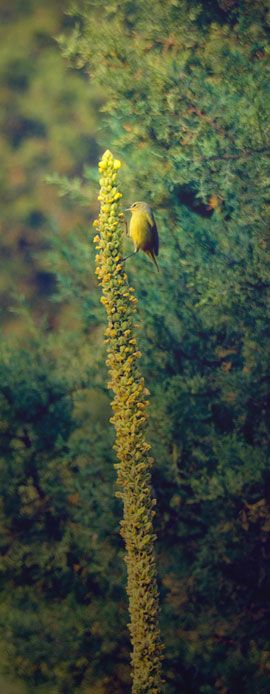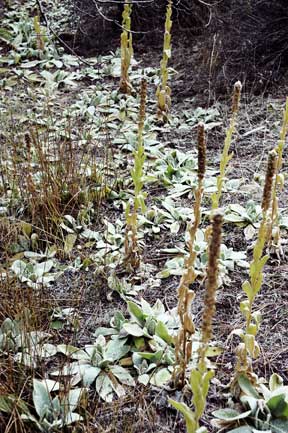Mullein is biennial, flowering usually in it’s second year. It is recognized by broad, light sage green leaves in a ground rosette; the leaves are thick and soft as flannel. The second year it sends up one stalk from which branches of small yellow flowers bloom with infinitely tiny red seeds. The flowers are quite exotic with small splashes of red on the end of the stamen. The flowers do not open at the same time and so provide nectar from early spring through first frost. I witnessed wild bumblebees, several varieties of butterflies and wild bees on the many mullein plants across summer into fall. The flowering stalks can be quite tall providing both long seasonal nourishment, and a plethora of flowers to feed from.


As for the wild bees, honey bees, wild bumblebees, and the butterfly species migrating across summer, mullein provides a safe harbor for clean nectar and seeds for migrating songbirds. The problem with most nursery plants is that they are treated with neonicotinoids or neonics. An unsuspecting gardener becomes part of the problem.
Neonics are pesticides that are neuro-toxins. Neonics stay in the soil for many years depending on the concentration and are absorbed into the cells of plants that are treated with the pesticide and grow in it. When a contaminated flower is visited by a pollenator, let’s say a bee, just coming into physical contact with the stem, flower petals, let alone the contaminated nectar, effects the bees
nervous system and it throws off their navigation system. They have trouble remembering where the hive was, since this is information is a neuro chemical. They may never return to the hive altogether, starving in isolation. When enough worker bees disappear the hive may die from starvation. If they do return to the hive, they bring the contamination to the hive and it is
accumulative.
Neonics also cause bees to not groom themselves and so they become susceptible to mites and infections. Neonics also kill birds and small mammals who ingest poisoned insects. Birds, fish, frogs, salamanders, otters, et.al are affected and this contamination increases in concentration through the food chain.
Few flowers and vegetable plants from commercial nursery stock are labeled as treated with neonics or herbicides. The lovely looking flower garden initially purchased at most commercial outlets is likely to be bee/pollenator killing zone! … The well meaning but unaware gardener is now part of the problem.
The problem with soils labeled ‘natural’ is that they may be contaminated with Milestone or other herbicides which will also negatively effect pollinators…. A small step to help is to simply allow mullein to proliferate on your property: new, old, or rental. Welcoming mullein and allowing it to thrive on your property will provide some support for pollinators and ultimately bird, and small mammal species. …consider mullein’s value to bees, bumblebees, butterflies, moths, dragonflies, who are needing nectar and nourishment that is toxin free, safe to consume. In this case, all you have to do is …nothing. What could be simpler?
Read the full article on Small Farmers Journal
About Alexis West
Author and photo credit. Education: M.S. Visual & Written Communications. Former teacher, park ranger.




